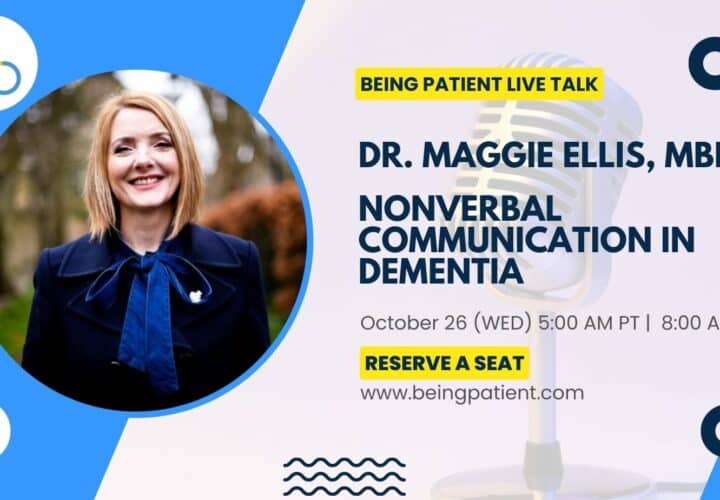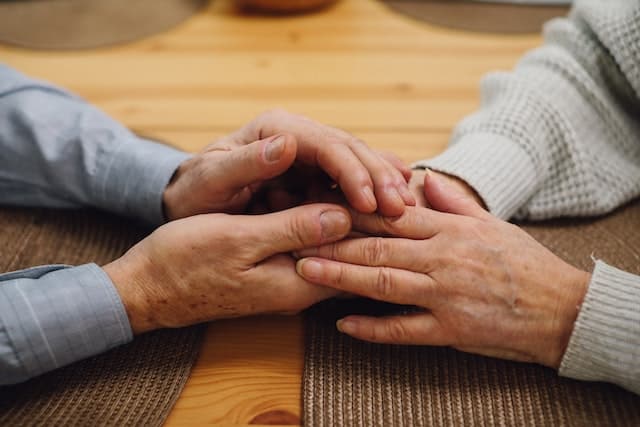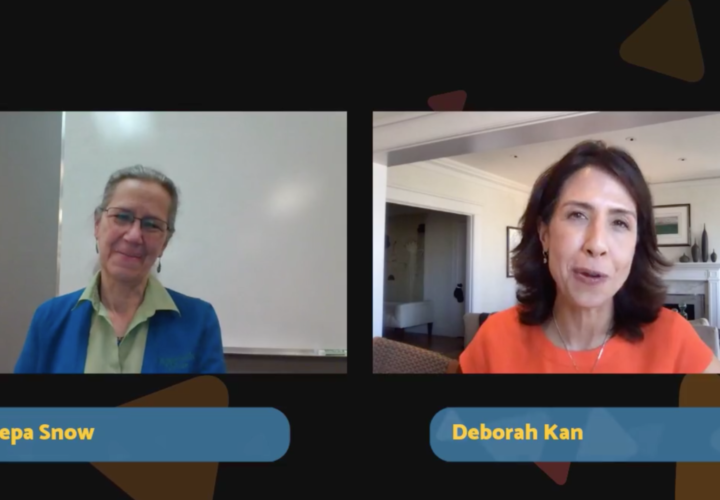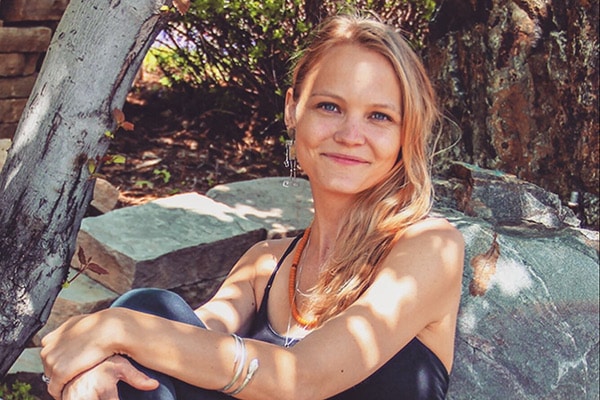Is there a way to communicate with people living with Alzheimer's who have become nonverbal? Dr. Maggie Ellis shares techniques around adaptive interaction, an alternative way of communicating for late-stage dementia patients.
Maggie Ellis, a senior lecturer at St. Andrews University, is currently studying a method of communication used with nonverbal individuals for its applications in late-stage dementia.
Adaptive interaction — a way of communicating that involves mirroring a person’s actions — is helping carers connect with nonverbal people living with dementia. The behavior matching practiced in adaptive interaction gets reactions like eye contact, smiling, laughing, and increased bodily contact.

The technique challenges misconceptions that people who are nonverbal are shut off from the world, as described in a recent Being Patient report on the approach.
In a Being Patient Live Talk, Ellis shares how adaptive interaction works, her research into adaptive interaction with nonverbal individuals living with dementia, and how she teaches the approach to others. She also shares the initial steps to take for practicing adaptive interaction, and where to find more information.
Watch or read the live talk below.
Being Patient EIC Deborah Kan: I know from my own experience with my mom; she’s been losing words lately. She’s much more animated in her gestures, yet she’s losing the words to communicate. I’m going to ask you this question backwards: Does the loss of words actually mean the person can’t communicate anymore?
Maggie Ellis: No. When a person loses words, and their vocabulary shrinks, they find different ways to communicate with us, which are generally based on the fundamentals of communication – how we learn to interact when we’re young infants. We use these actions throughout our lifetimes, and we don’t really think about them because we talk. But when speech leaves us, we can then rely on these fundamentals of communication. That’s what happens with people with advanced dementia — they communicate in a different way.
When a person loses words, and their vocabulary shrinks, they find different ways to communicate with us, which are generally based on the fundamentals of communication.
Being Patient: I noticed when I see my mom, she can’t always tell who exactly I am, but she knows that I’m someone who she can trust and I’m familiar. When she greets me, she’s very animated. She uses a lot of gestures. Instead of saying “Hi I’ve missed you so much,” she’ll say — “Hello!” and there’s a lot of gestures. In a weird way, that makes me feel really good because I feel like, oh, she does know who I am. She’s able to gesture with enthusiasm, although she’s not able to explicitly communicate anymore. How should I react to that? Is just telling her, “Oh mom, it’s so great to see you,” is that enough? Or should I be doing something else to really let her understand that I understand where she’s coming from?
Maggie Ellis: That’s a good question. When she’s engaging with you using these really animated actions, my suggestion to you would be to try and reflect those in some way. So if she says hello and then she’s [gestures] with her arms, gesticulating, I would try to feed that back to her in some way. It might feel a little bit strange at first, but if you think about it as you’re reflecting her emotions via those actions, you’re letting her know that you’re also happy to see her. I think that would be a good start. If you do try that, I’d love to hear how it goes.
Adaptive Interaction
Being Patient: So you have a term for this. It’s something you teach people to communicate non-verbally. Tell us a little bit about the technique, adaptive communication, and what do we know about that type of communication?
Maggie Ellis: Adaptive interaction is based on an intervention called intensive interaction, which was designed in the 1980s to help people with profound and multiple learning disabilities and accompanying severe communication problems interact with their family members and carers. These individuals that we’re talking about have no speech, maybe one or two words. But they may use actions to communicate.
It may be that the person has several different actions in their vocabulary — the person taps or claps, or they may make a repetitive sound that may get louder and louder depending on the situation. We can consider these actions as parts of the fundamentals of communication that we use when we enter the world and that these skills are developed into speech over time.
If you think about a young infant, I’m thinking specifically of my great nephew at the moment, Oliver, who is starting to communicate more and more, he’s six months old now, and he’s making lots of sounds — “aaah!” and lots of movements, lots of eye contact and smiling. All those things that you do very naturally with a young infant to develop their speech.
You can take those and use them with profound and multiple learning disabilities and use their vocabulary to communicate with them. Intensive interaction is used to basically to communicate with people, but there are other functions involved in it. The other functions involved are developing relationships between the person — carers and family members — over time, so the person is likely to remember who you are from one session to the next, and the other aim is for them to have some basic learning involved.
Many years ago, when my main collaborator and I, Professor Arlene Astell, and I were invited to a conference on intensive interaction, we saw that there may be some potential for this approach to be used with people with very advanced dementia who have no speech or very little speech. We tried it very early on, and there seemed to be some potential in it, but we knew that the aims would be slightly different.
Being Patient: Can you give us an example of what that looks like in someone with late-stage dementia?
Maggie Ellis: Someone in very late-stage dementia may appear to be completely uncommunicative, so by this stage, the person may be completely immobile, no longer able to walk around or feed themselves, or do any activities. By this stage, you’ll often see that all speech, or the majority of speech, is gone, and understanding the speech of other people is also severely compromised. So the person is in their own world, not understanding anything that’s happening, unable to communicate via words.
The similarities we’re talking about here with the vocabulary of actions that the person may have with young infants and people with learning disabilities – we all have these vocabularies as well, but we don’t think about them because we talk. You might see a person at this stage of dementia maybe rubbing themselves, picking at their clothes, or making a sound.
Being Patient: Tapping is a common one.
Maggie Ellis: We knew that our approach would have to be slightly different than intensive interaction because of the severe memory impairments in advanced dementia. We couldn’t expect to build relationships with the person over time. We couldn’t expect someone to remember us from one day to the next and there could be no sort of curriculum involved in this. This approach would be used specifically for connecting with another person, for finding a way to connect with this person. We adapt to whatever the person brings to the table at that time. We don’t introduce actions that would engage them in previous sessions because the person may not remember that. We adapt to whatever they bring, therefore, adaptive interaction – that’s where the name comes from.
Being Patient: Let’s take the tapping example. Some people pace. In a later stage of dementia; those are both two very common things. If we start to mimic, in your research, how do you know that that’s comforting to a person? What gives you those signs?
Behavior matching vs. mimicking
Maggie Ellis: First, I would say that we are not mimicking the person. What we are doing is behavior matching. Mimicking has connotations of being nasty to someone or taking something away from the person. Stuff you would imagine in the playground. If we engage in behavior matching, it may not be out and out repetition of what the other person does. It may be if the person taps, you might make the sound and the rhythm of the tapping in some other modality.
Being Patient: When I was thinking of it, I was thinking more of copycatting. repeating, repetition, but it’s not, you’re saying it’s different.
Maggie Ellis: It adapts. Don’t get me wrong, there are times when you will directly do what the person is doing, and we often do that when we start this approach because we’re uncertain of what is going to work and what isn’t. It can start with that, but the interaction develops over time.
In answer to your question about how we know it works – we see increased eye contact, and we see smiling. We see laughing, and we see people reaching out for bodily contact. We see a continuation of the interaction, we see this eagerness to interact.
We see a continuation of the interaction, we see this eagerness to interact.
Being Patient: What is your interpretation of what this means to the person with dementia? Based on those behaviors, what are some of the conclusions that we can draw?
Maggie Ellis: I think the conclusions that we can draw are quite simple but global at the same time. It’s about the other person being seen. If the other person recognizes that their communication partner speaks their language, so to speak, then they feel seen and validated and then want to interact with that person. We have compared adaptive interaction to speaking to the other person, to engaging in lots of different activities, like reading to the person, or playing music to the person. Nothing gets the same reaction as this behavior matching.
Being Patient: I notice when my mom is most frustrated is when we’re having a conversation she can’t keep up with, especially if multiple people are talking at one time. This does make sense to me, in the sense that you’re stopping and acknowledging where that person is, which is respectful.
If the person is no longer verbally communicative, how do you start to integrate some of these modified behaviors? Where should we start?
How to practice adaptive interaction
Maggie Ellis: I compare it to being a detective. If I were to go in and meet someone for the very first time, what I would do is sit next to them, and see what they’re doing. Observe. Are they engaging in any sort of actions that you can identify?
I compare it to being a detective. If I were to go in and meet someone for the very first time, what I would do is sit next to them, and see what they’re doing. Observe. Are they engaging in any sort of actions that you can identify?
Is there tapping, is there any touching of the body, are there any sounds? Is there any eye gaze? Spend a bit of time observing the person first. Once you have an idea of the actions they might engage in, you can think about turning your chair towards them, making eye contact. Perhaps try to smile and see if its reciprocated. It might not be. It might be a frown.
I would start slowly and pick one thing first. Let’s say that it’s tapping. I would try some tapping with the person and see what happens. It’s not terribly prescriptive, it depends on how it develops in the moment.
Being Patient: Should we be verbal, or should we not as we’re interacting?
Maggie Ellis: If the person is at a stage, and we can assume they are, at a stage where they no longer understand speech, then speech is meaningless to that person. What is meaningful to that person is their own vocabulary. So I wouldn’t. It wouldn’t make any difference if you used speech; in fact, it might cloud the interaction somewhat. It might make it less pure.
Being Patient: I’ve always assumed that the understanding is there, but the communication is lost. I assumed that even though my mom can’t articulate things, she definitely still understands — she’s still communicative. I guess in a later stage of dementia, I don’t know. How much do we actually know in terms of what they’re understanding?
Maggie Ellis: That is also a really good question. We have to give sort of a proviso when we talk about this stage of dementia — for as much as we can tell, speech is no longer understood — this is at very late stages. People understand speech for a long time, and there is a stage at which they will understand what you’re saying but will be unable to give you back anything that you understand. There is a stage beyond that where we can assume that the person does not understand speech at all. We’ve been able to show that in some of the work that we’ve done; when I said to you previously that we used speech-based interactions to try and engage with the person with advanced dementia, we designed a set of closed questions that would require a yes or no answer. Since the person wasn’t able to talk, they could nod or shake their head in response.
The person that we worked with on this particular study was not able to do that. When we asked the question, we left a huge gap in-between to give him time to process the information, and there was no discernible response. People will understand for a long time, but we have to remember that there is a stage beyond that which they may not understand speech at all.
Being Patient: So that’s where adaptive interaction becomes very meaningful. Thank you, Dr. Maggie Ellis, and thank you so much for joining us. If people want to know more about adaptive interaction, how do they learn more?
Maggie Ellis: They can contact me at the website, Astellis.co.uk – we have training options on the website. We have a book on adaptive interaction that’s written for carers, it’s very accessible, that is available from Amazon. There are also articles on our website that are written for practitioner journals which are also very accessible. I am also available if you want to email me. My address is on the website.



